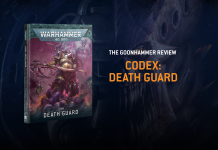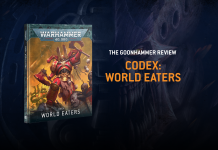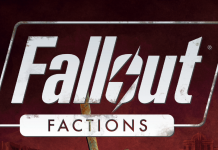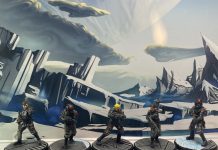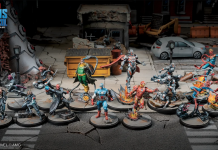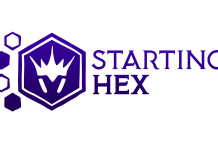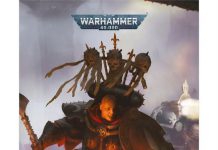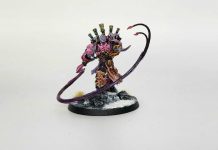With GW’s announcement that Squats are returning, it felt like a good time to have a detailed look at the history of Squats, or Space Dwarves, in 40k. The Squats are a faction with a very weird and spotty history in the 41st millennium, having gone from a major range in the game’s first edition to being completely absent ten years later and the subject of ongoing jokes. Today we’re going to look at their origins, their developments, and how things have changed with the recent and upcoming releases.
The Miniatures
The first Squat miniatures actually predated the publication of Rogue Trader. Rogue Trader was published in 1987, though had been in development for years before that (and delayed due to Warhammer Fantasy Roleplay and Rogue Trooper and that’s a whole other story). This meant that GW had a number of models and prototypes in the pipeline ready to go when it was published, and some were out before Rogue Trader was available for sale.
Squats were one of these, with the initial Squat model, Irn Bonce, featuring in the Mercenaries range, and appearing in the March 1987 Citadel Flyer. At this stage Games Workshop and Citadel miniatures were substantially less slick and more amateurish than today (hence the multi years to develop and release 40k, and the issues with name changes and different drafts that it went through) and Citadel were trying out different science fiction ranges, heavily influenced by Warhammer 1st edition and its more heavy tabletop RPG-esque approach.
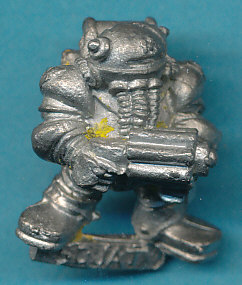
You can see this in Rogue Trader, as it doesn’t have army lists and you essentially create a force with complete freedom. This changed with the White Dwarf army lists, which were later collated into the 40k Compendium and 40k Compilation, and which created army lists and set equipment for factions. As these releases came out they would eventually push factions towards certain equipment (bolters for marines, shuriken catapults and lasguns for Eldar, etc), but at inception it was incredibly freeform.
This meant that you could slot all these weird figures, like the Mercenaries or Adventurers ranges, into a 40k force with only the time it took you to manually work out and add up the cost of your force as a barrier. Bear in mind there was a lot fewer distractions in the 80s.
Very early Rogue Trader had several marketing flyers, and ranges appeared in these, as well as in the Book of the Astronomican (the first 40k supplement) and White Dwarfs. Most of the pictures in this article are taken from these sources. There were several distinct releases that formed the early Squat range, including no less than three large infantry ranges.
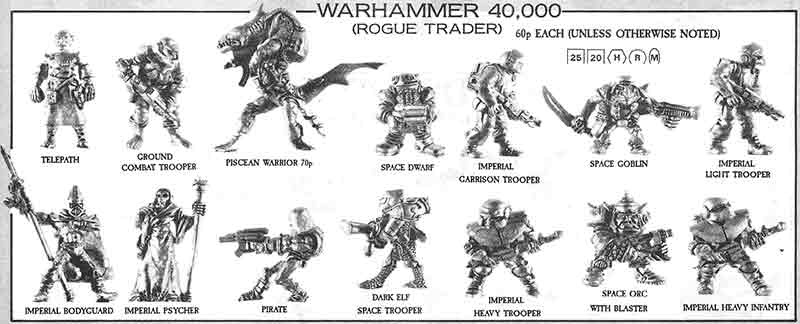
So Irn Bonce was simply the first model of many, because Rogue Trader era GW really loved Squats, and the Rogue Trader book showed off a new Squat range, RT301 (GW renumbered their catalogue around this time, with the Cxxx numbers, C standing for Citadel, changing to other letter codes, most notably RT for Rogue Trader). This comprised 20 figures and was in White Dwarf 94, the Book of the Astronomican and the Thankyou Mr President flyer (this flyer addressed Black Monday and the Dollar Stabilisation that affected GW prices in the US market). This range was trimmed down and by 1991 only eight of the models remained in production. There was also a limited resculpt of four figures, which had a separate back pack to make them one piece castings.
For 40k oldtimers, you may remember the Thankyou Mr President Flyer having the metal Space Marine, Space Ork, Space Elves and Space Squat ranges and it is worth noting that the Squats were the biggest range of figures in the initial Rogue Trader pre-launch offering, with 20 sculpts to Space Marines 13, Space Orks 17 and Space Elves 12. Squats were a big range from the start.

But 1987/8 saw a wealth of other releases, because this was early GW and a bit chaotic.
Devastators was a boxed set featuring the Space Marine Landspeeder, Imperial Guard Tarantula, and a Squat Mole Mortar. This was a boxed set that had a Space Marine unit, an Imperial Guard unit and a Squat unit, and they all unsurprisingly ended up available separately later, where you could order two gunners and whatever weapon you wanted, and the Landspeeder gained alternative Imperial Guard crew.
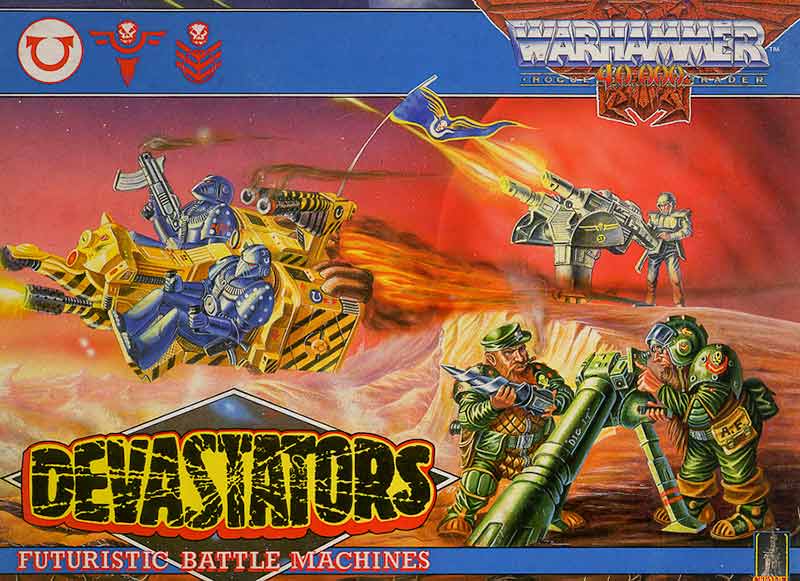
Heavy weapons (RT9), with gunners with separate over the shoulder weapons (GW loved this, releasing Imperial Guard, Ork and Space Marine miniatures with a similar set up as well) and two loader sculpts.
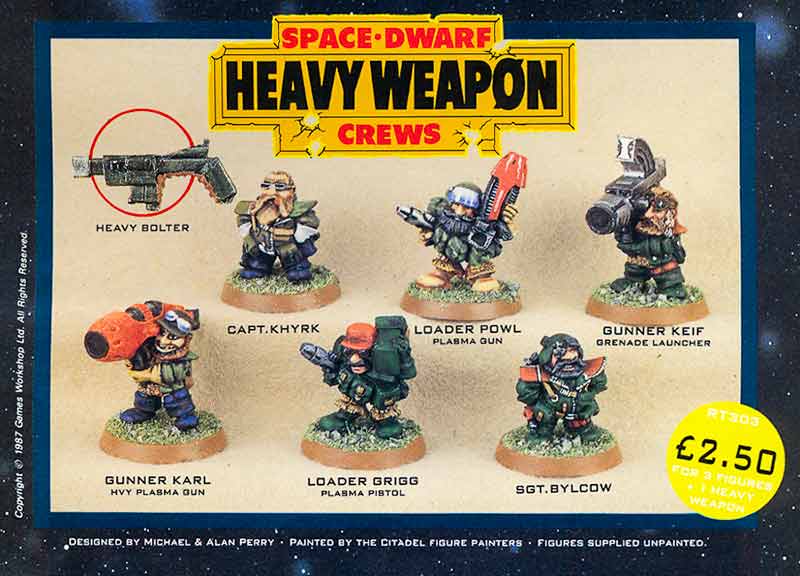
Command Squad (coded as RT03), because every force needed officers, standard bearers, musicians and champions. There were three poses of each, all based on the same dolly, though only two of each pose was in the marketing material.
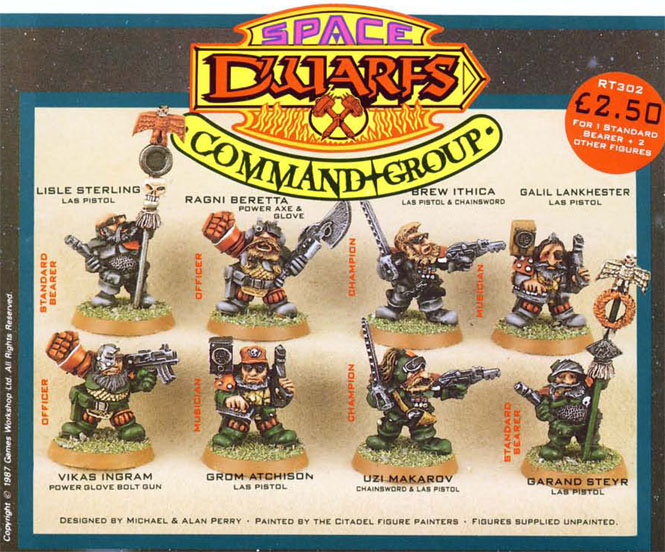
The Adventurers set (RT601) gave us a Squat Miner and Engineer, and was another menagerie of different models that could be popped into the more RPG style games of Rogue Trader.
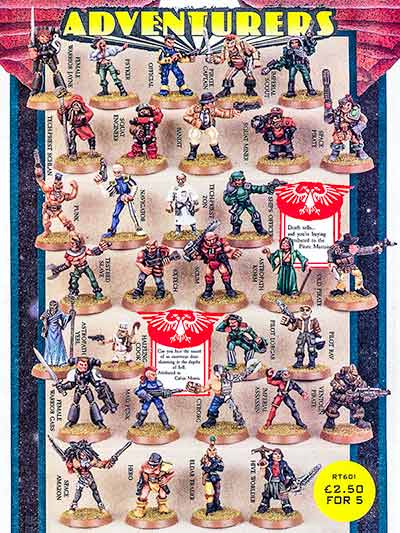
The Iron Claw Squat Aircar appeared in 1987 but didn’t stay in production. I would guess that this was because it looks a real pain to cast with 1987 technology, and it doesn’t appear in the Squat army list that appeared in White Dwarf 111.
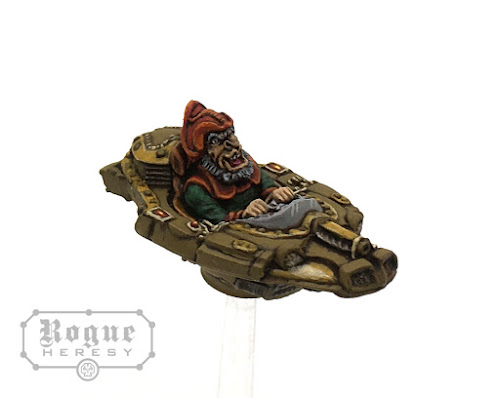
A second full set of infantry sculpts, by Bob Olley, was released in April 1988, with 32 new sculpts. All but one of these were dropped from the range by 1991.
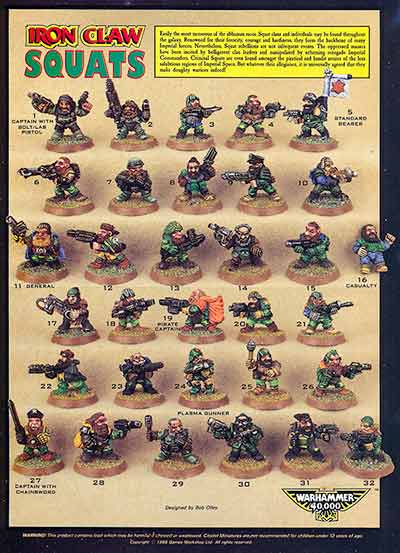
RT304 – Thudd Gun and Operator, by the Perrys, followed this in May 1988.
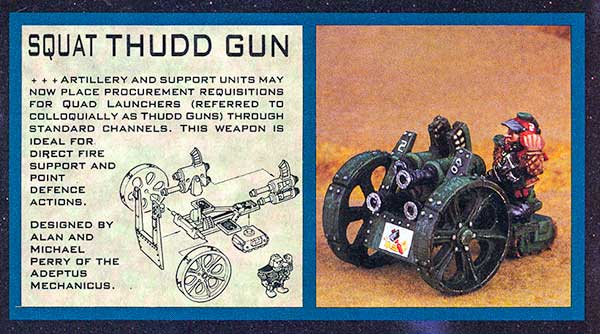
Medics (this involved releases for Space Marines and introduced Apothecaries, Imperial Guard and Squat Medics) and added two medics sculpts.
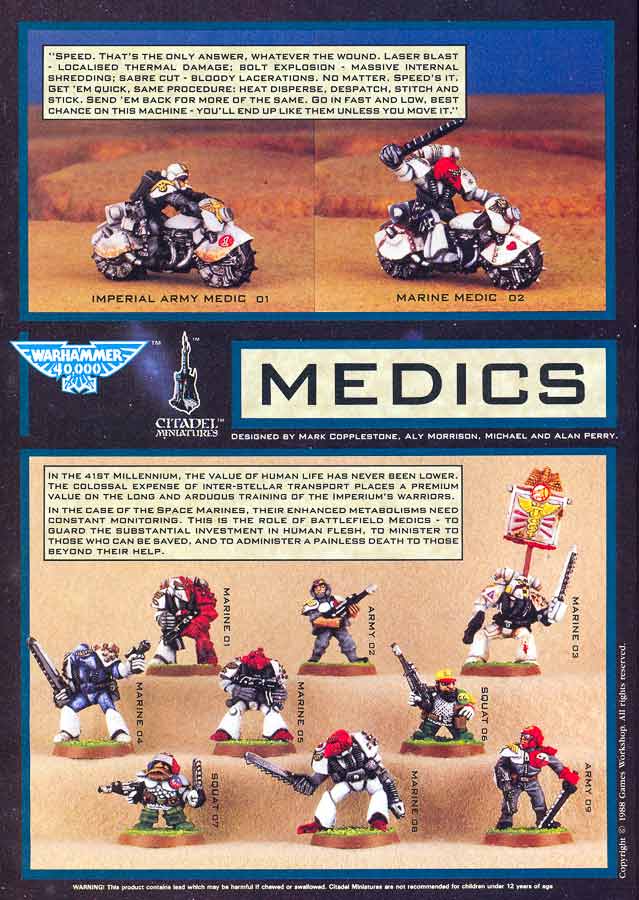
Bikes and Trikes were July and August 1988.
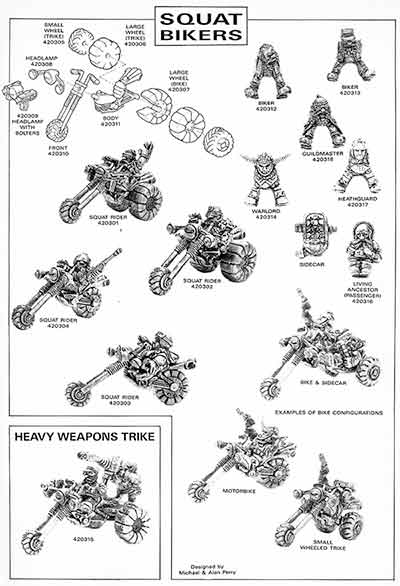
A third full set of infantry sculpts, with another 32 miniatures, was released in White Dwarf 108.
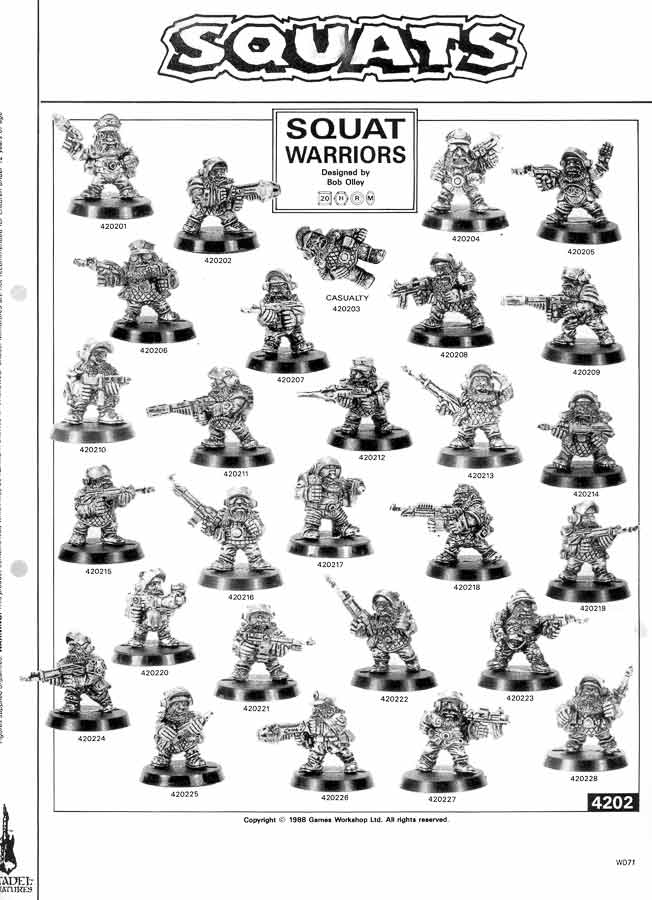
This first big wave, spaced over about a year, comprising over 100 different models and various artillery and vehicles. Squats were being released on almost a monthly basis, and were definitely one of the core four ranges of Rogue Trader.
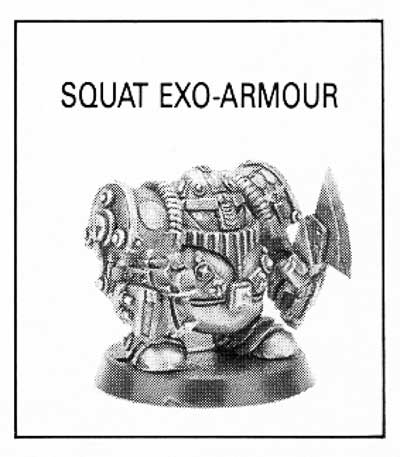
1989 saw the release of Squat plastics, and the plastic (arms and weapons) metal (bodies) hybrid models. These models introduced the units that were in the army list published in White Dwarf 111, including Hearthguard, Guildmasters, Living Ancestors, Admech Squats, Exo-Armour and Warlords.
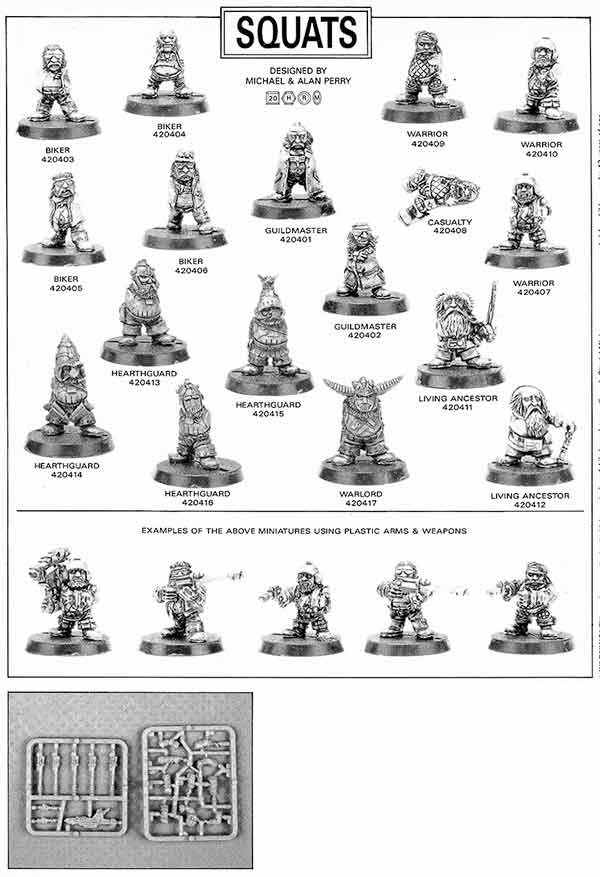
With the previous years’ releases, Squats had plastic infantry, metal bikes and trikes, a very large assortment of different metal infantry, and an assortment of weirdos from sets like the Adventures or Mercenaries.
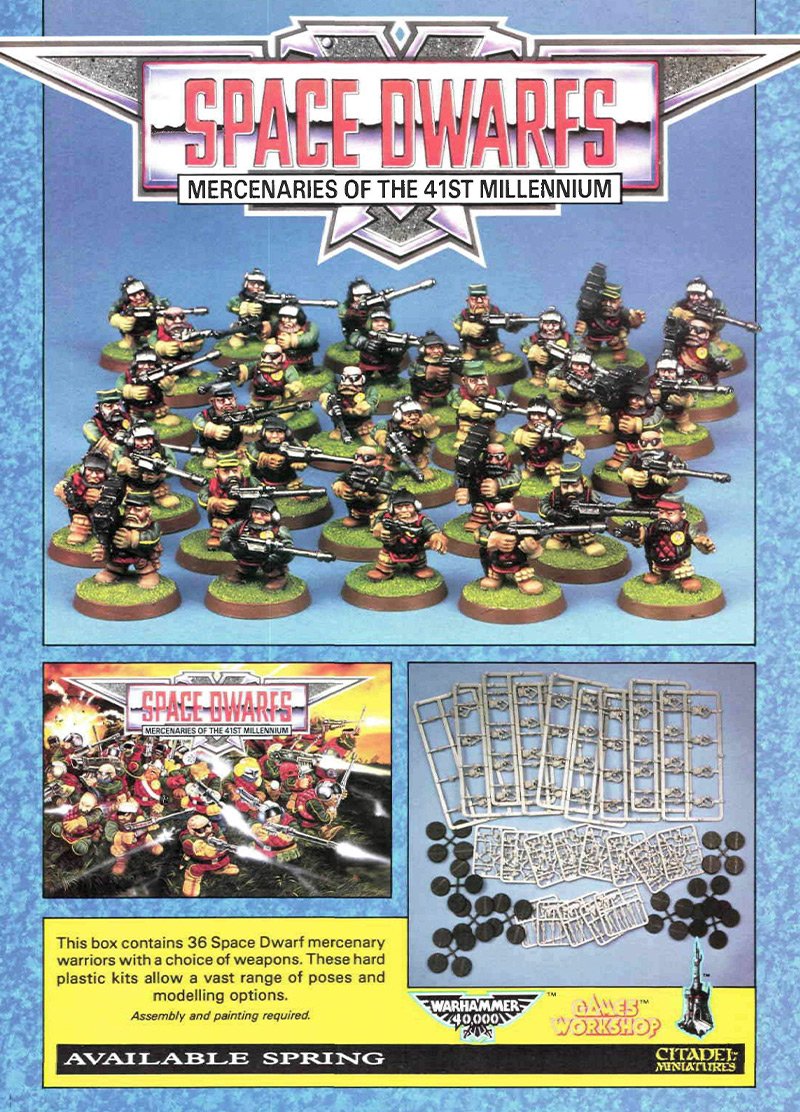
To this even more Squats were added – Chaos Squats (including power armoured Squats that used the Chaos Marine backpacks), Squat Adventurers and even Pirates (all using the plastic arms and weapons sprues). The Pirate range, despite being available in the UK and US and consisting of ten models (with only two of them having hook hands, which was very restrained on GW’s part), never appeared in any of the catalogues.
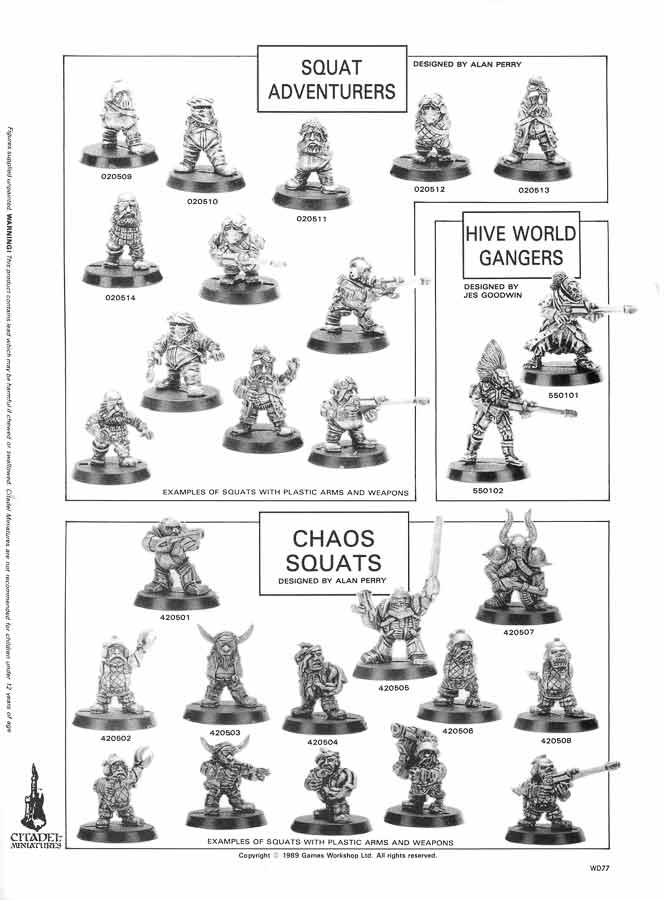
By the end of 1989 GW had sculpted and distributed about 150 metal Squat models, making Squats a fairly substantial range up there with Space Marines in terms of model numbers.
However GW culled a lot of sculpts prior to the Blue Catalogue, the Citadel Catalogue published in 1991. Almost all of the early Squats went, including most of the Iron Claw ranges, and the assorted mercenaries/adventurers etc, as GW moved to consolidate their ranges around the actual 40k game, which now had organised army lists published in White Dwarf and republished in the Compendium and Compilation, and moved away from producing mixed groups of essentially sci-fi RPG figures. GW was becoming a bit more corporate, and a bit less random in their releases.
This period (87-89) was the high watermark of Squat releases, with models coming out regularly and appearances in White Dwarf almost every month, even if just in the ‘Eavy Metal section. From 1990 to 1993 Squats turned up sometimes in pictures in White Dwarf, but there were no 40k releases. As 40k cycled through attempts to fix the vehicle rules in Rogue Trader Squats were updated (and armour penetration rolls were introduced at this time, which lasted until they were scrapped in 8th edition which went back to vehicles having wounds and toughness like in Rogue Trader).
If you’re looking to oldhammer it up and try collecting miniatures that have been out of production for 30 years, then the Squat page on Collecting Citadel miniatures was a really useful resource for me in researching every Squat mini GW ever produced.
What did happen was that Squats were added to, and filled out in terms of vehicles and units for, Epic. A range of vehicles including Gyrocopters, Armoured Airships, Overlords and Land Trains were introduced to Epic, and Squats again acquired cult status. A plastic sprue of infantry, bikes and artillery made collecting the force easy, and it played well in Epic Space Marine 2nd edition with the release of Ork and Squat Warlords.
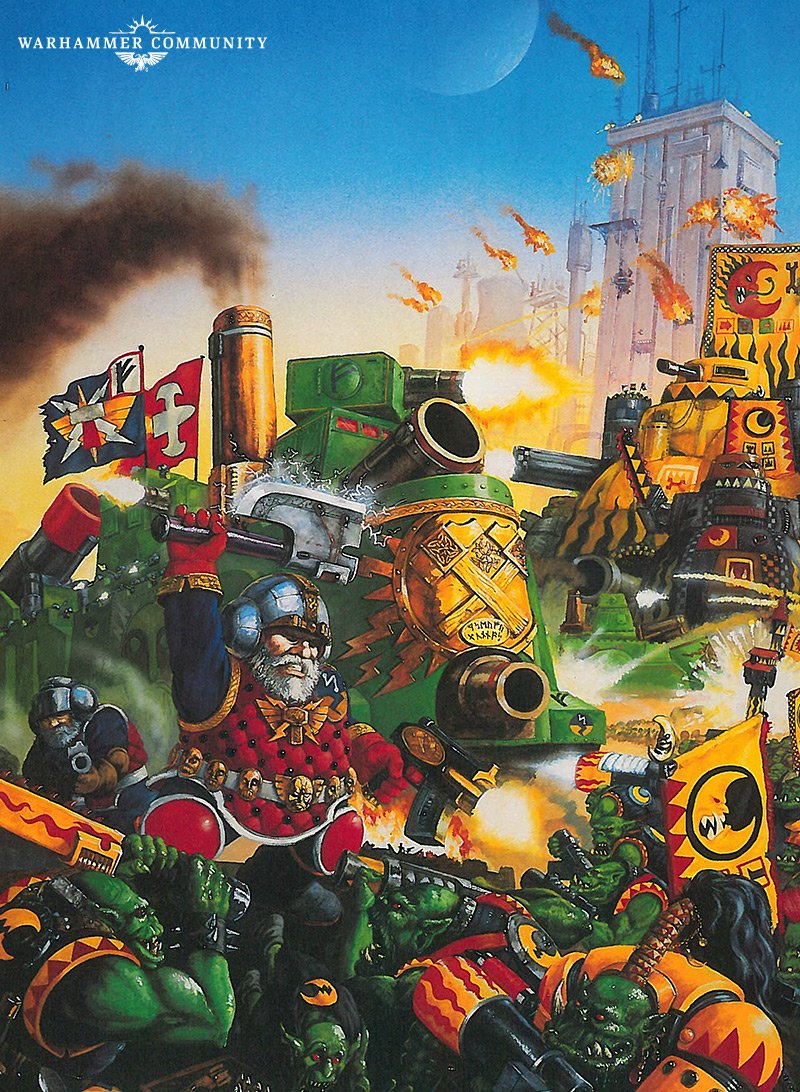
This was Epic’s golden age, and when a lot of people with fond memories of the game were playing.
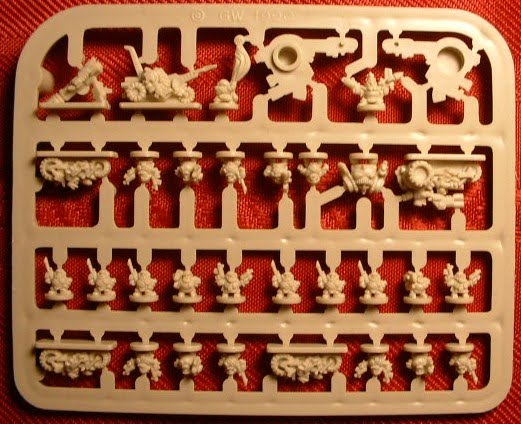
2nd Edition Warhammer 40,000
As GW entered 2nd edition with the first 40k boxed game in 1993, the Squat army list was updated in Codex Imperialis, the army list booklet included in the 2nd edition boxed set (this was essentially the equivalent of 8th edition’s Index books). This reflected the Rogue Trader miniatures line that had survived the culling in 90/91, and it was a fairly reasonable army list. Squads had 13 units to choose from, and in addition to their bikes and heavy weapons bikes could take Rhinos and Land Raiders for transport.
Unfortunately, it was the last time Squats had an army list published by GW. They’d get some final support in 1993’s Dark Millennium expansion, receiving four psychic powers and matching cards for Ancestor Lords to manifest in battle.
There were some prototype Squat models produced during 2nd edition, but none were made available for sale and those circulating very occasionally on ebay are from staff members who got copies.
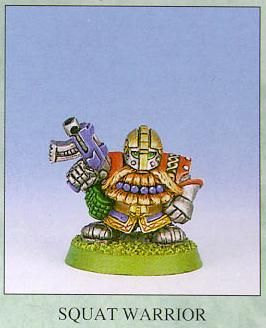
Cyber Slayers were introduced as a concept, and an updated exo-armour, but the Studio felt like it didn’t have a real idea of where to take the Squats, and there were no more releases for them.
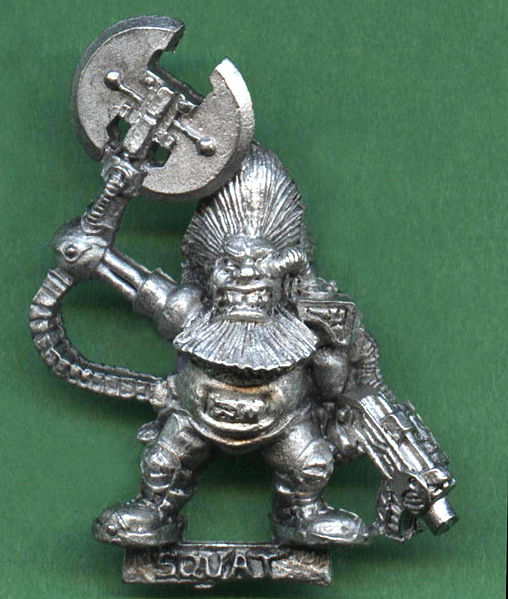
The Squat Warrior by Kev White was a bit more like the classic Squat range, but with a new type of gun.
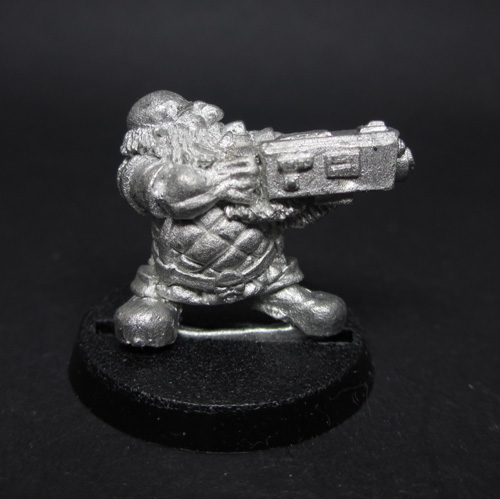
The Death of Squats
This was confirmed by Jervis Johnson in a forum post in July 2004.
‘Seriously, a couple of points just so you can have an informed debate based on the real reasons that Squats are no longer available. Be warned, it is going to be hard reading for people that like the Squat background.
First of all, Squats were not dropped because they were not selling well. There were then, and are now, plenty of other figure ranges that sell in the sort of % quantities that the Squats pulled down, especially when you look across all of the ranges produced by GW rather than just those for 40K.
No, the reason that the Squats were dropped was because the creatives in the Studio (people like me, Rick, Andy C, Gav etc) felt that we had failed to do the Dwarf ‘archetype’ justice in its 40K incarnation. From the name of the race (Squats – what were we thinking?!?!) through to the short bikers motif, we had managed to turn what was a proud and noble race in Warhammer and the other literary forms where the archetype exists, into a joke race in 40K. We only fully realised what we had done when we were working on the 2nd edition of 40K. Try as we might, we just couldn’t work up much enthusiasm for the Squats. The mistake we made then (deeply regretted since) was to leave them in the background and the ‘get you by’ army list book that appeared. With hindsight, we should have dropped the Squats back then, and saved ourselves a lot of grief later on.
Anyway, the Squats made it into 2nd edition, and since we were doing army books for each of the races, we started to try and figure out what to do with them. Unfortunately we just couldn’t figure out a way to update them and get them to work that we felt was good enough. The ‘art’ of working on an army as a designer is to find the thing that you think is cool and exciting about an army, and work it up into a strong theme. This ‘muse’ didn’t strike any of us, and so, rather than bring out a second-rate product simply re-hashing the old background, we kept doing other army books instead, with stuff we did feel inspired by.
Now, while this was all going on for 40K, we were actually doing some rather good stuff for the Squats in Epic. On this scale there was a natural tendancy to focus on the big ‘hand-made’ war machines the Squat artisans produced, and this created an army with a feel that was very different to the biker hordes in 40K. However, this tended to reinforce the problems we saw in the Squat background rather than alleviate them, underlining what we should have done with the Squats in 40K.
In the end (and it took years to really get to the roots of the problem) this led to a realisation that we were going to have to drop the Squats in their ‘Squat’ form from the 40K background. There was little point having a major race that we weren’t willing to make an army book for, and their inclusion in the background meant that people kept asking us when we’d do a Squat Codex. Instead we decided that we’d write the Squats out of the background by saying that their Homeworlds had been devoured by a Tyranid Hivefleet. This would give us the option in the future to return to making a race based on the Squat archetype for 40K. This race was given the name of Demiurg, and a certain amount of preliminary work was done to get a ‘feel’ for what the race would be like. At present the only hint of the Demiurg in 40K is the Demiurg spaceship for BFG. However, we do have this race ‘in our back pocket’ as a possible new race for 40K, or an interesting character model in Inquisitor, or whatever. So far the Demiurg have lost out to other projects, and it may be that their time never actually comes, as they will have to win through on their merits, not simply because we once made some Squat models in the past. At present, I have to say that it is more likely that they don’t make the cut than do, as there is a certain prejudice these days to simply taking races from Warhammer and cross them over to 40K like we did in the early days, so it may be that the Squats/Demiurg end up remaining a footnote in the history of the 40K galaxy. Only time will tell…’
And that was it. The Squats in 40k lacked the strong aesthetic they had in Epic because they lacked all the cool warmachines that Epic forces were built around, leaving the light forces (brotherhood and guild bikers) that really didn’t grab the imagination.
The Modern Revival
This was the beginning of the Long Night for the Squats. The Demiurg appeared in Battlefleet Gothic, and kept stout little beardy fellas alive in the background, but there were no Squats miniatures until Boxed Games produced a Squat for Necromunda – Grendl Grendlsen, in 2018.
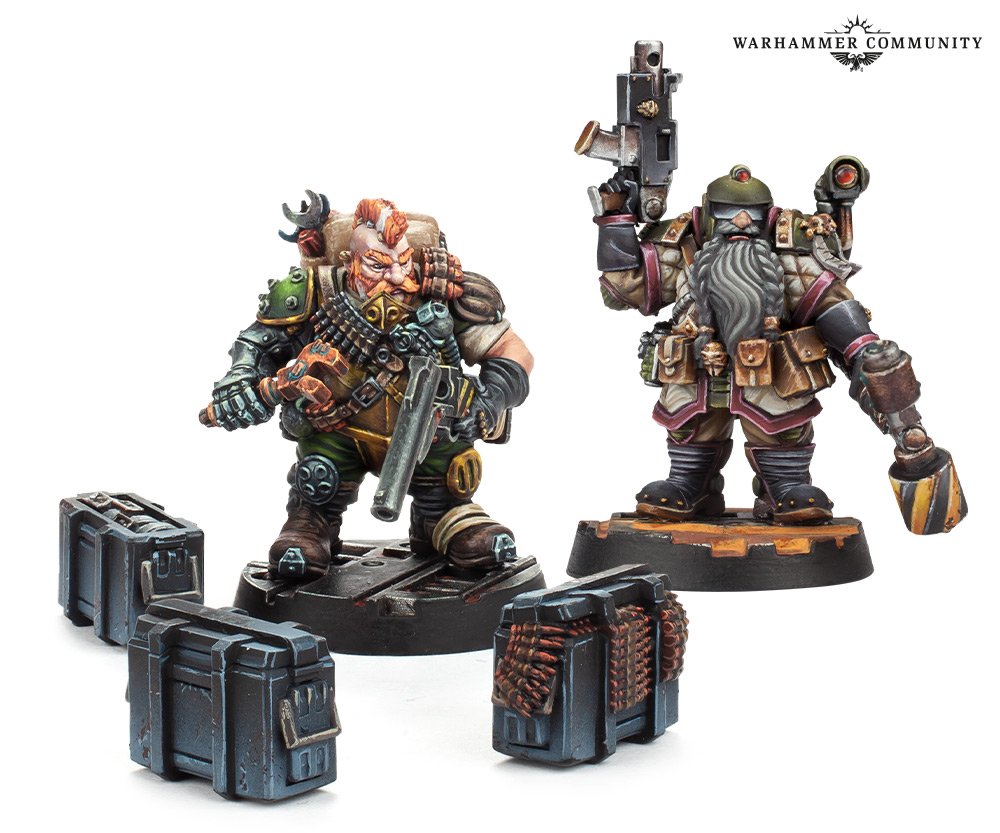
This miniature had the classic Squat-style helmet and quilted flak armour, and was a nice callback to the classic GW Squat style. It was also a nice little test to see if people still liked Squats, and did sell quite well. Grendl was soon joined by Ragnir Gunnstein, who had an aesthetic more like a Fantasy Dwarf Slayer than classic Squat.
Since then we’ve seen hints in the fluff and occasional mentions in Black Library, but nothing concrete, apart from a rumour that Squats were coming back (though given GW minis are designed years before release, I’ve given up on model rumours, particularly as the last time I heard Squat rumours we got Kharadron Overlords in AoS a couple of years later).

The new miniature shown is an aesthetic break from the previous Squat range, being more of an asteroid miner than dwarf in space, and the goal of this break seems to be to make them more than just “Dwarves in space.” Contrast the new Squat model with the mining suit Genestealer Cultists for example, and there are aesthetic similarities. It looks like the model is in an armoured mining suit with back pack (which leaves it open to being semi-powered armour, and you used to be able to take a power armour cuirass in Confrontation) and this hints at asteroid miners. Warcomm states that they come into conflict with Orks, who love strapping rockets to asteroids to help them get where they are going.
Personally I like it, but hope we’ll see some influences of the old Squat range, like cool helmets and exo armour.
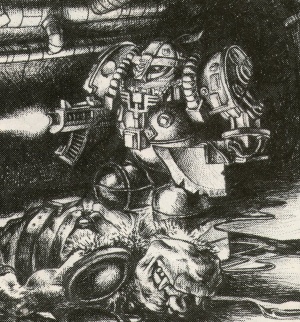
The Lore
The original Squats were based around Strongholds (themselves based around a mine or other economic unit, though a trade fleet or similar space based Stronghold would be entirely possible), which were very much Dwarf clans in space. These strongholds were organised in leagues, which were the faction’s larger political units. These leagues could comprise only a few strongholds on the same world, or comprise thousands of Strongholds across dozens of worlds.
Each Stronghold is ruled by a hereditary Squat Lord with a group of hereditary retainers. I know what you’re thinking, a warrior aristocracy with a selection of fashionable headgear that highly value honour. What does that remind you of? Samurai! Or the various Viking successor kingdoms of the early medieval period such as the Anglo-Danes, but a hereditary lord and retainers forming a permanent standing force is a staple of medieval societies.
And Squats follow this pattern – the Lord and his Hearthguard similar to a Lord and his samurai, and the Brotherhood comprised of ordinary citizens taking up arms and reflective of the Anglo Saxon Fyrd or Ashiguru (though more reflective of Ashiguru due to the level of training).
It will be interesting to see if new Squats follow this pattern and we have a Lord, his retinue in Exo Armour, and then a more lightly armoured Brotherhood style unit.
The Brotherhood were your standard Squat warriors or mercenaries, and had around a hundred miniatures available to choose from in the initial Squat range. They wear flak armour, and had boltguns, lasguns, space AK-47s, various special weapons, etc. These were well represented by the Iron Claw ranges, but were largely replaced with the plastics and plastic/metal hybrids. Brotherhoods often wander the galaxy operating as money hungry mercenary bands, dudes rocking around the galaxy shooting orks for money, which is something they’d probably have done for free anyway.
Needless to say, the society of Squats was very much the Warhammer Fantasy Dwarves in space. On that note, thinking about it I’m surprised no one has drawn the parallels between Samurai and WFB dwarves before because Throne of Blood but with Dwarves would have fit very nicely into WFB.
The new Squats continue to use Dwarf rune-style script, keeping that link with the old Squats. I know that Scandinavian runes have become closely associated with certain unsavoury groups, and these groups damage everything by association, but you can’t let them render entire cultures that aren’t even their own unusable for the rest of the planet.
So these leagues resemble the Hanseatic League of the late middle ages, though you could also compare them to the Delian league of the Persian Wars era, where there are a lot of nominally independent political bodies tied together economically and for mutual defence. The Leagues of Votann seem to drop straight back into this lore.
Most people don’t get that the Tau background is based on the British Empire of the 19th century, particularly prior to the Indian Rebellion of 1857 and that the Tau caste system, particularly with a caste at the top of society manipulating everyone for their own ends with no regard for individual life (which seems to be a satire on the English class system), is another reference to this. So yeah, if Leagues of Votann are a reference to the Hanseatic League or Sengoku era Japan I fully expect some people not to get that and just think Vikings, and not even the late Viking Empire with the Anglo Danes and the quagmire of the Irish wars which is much more interesting.
GW often base their factions’ lores on human history taken to extremes. However often, because people are often terrible at reading the meaning of media (hence the popularity of performative ignorance on YouTube where people either deliberately don’t understand media for attention, or are unable to understand things because they lack the intellectual ability to), they completely miss what the references are. You may disagree with me, but the Cinema Sins guys exist and they don’t understand movies made for children for a living.
In Rogue Trader the Squats evolved from standard humans during the Dark Age of Technology, having settled in the resource-rich but generally arid Squat Homeworlds. They traded with the Eldar and Orks, who had a series of wars with each other while the Squats remaining neutral and continuing to trade. Then the Orks attacked the Squats, the Squats asked the Eldar for help under the treaty they had with them, and the Eldar refused. This again reflected the WFB lore where there were long-running feuds with the elves and a deep hatred for orcs.
In that background the Squats are Imperial allies, providing mercenary brotherhoods to the Imperium as their tithe after rediscovery, and Squats served on both sides during the Horus Heresy. There are also dark rumours that Squat planets lost in warp storms during the Age of Strife have been twisted by the awful effects of the warp.
This supported the Chaos Squats range, and the Chaos Squats seen in Epic.
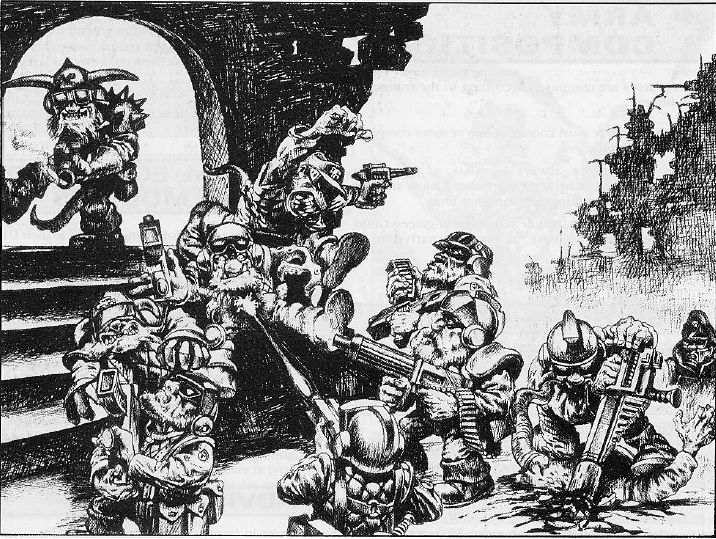
Squats also had the Engineers Guild, who were sort of an equivalent of the Adeptus Mechanicus without the superstition, who act as an independent body with enclaves in every Stronghold. Again, this was directly equivalent to the Dwarf Engineers Guild in WFB. But it let Squats take the ultra cool Squat Admech figure.

Living Ancestors were long lived Squats, living substantially longer than the average Squat lifespan of 300 years, but acting as an advisor to the Warlord and living link to the past, and potentially developing psychic powers to give Squats access to the psychic phase.
It will be interesting to see what has changed with the new Squats. It’s unlikely GW will keep them as just fantasy dwarves in space, so it’ll be interesting to see which avenues GW go down with them.
The new lore – hints and possibilities
There’s been some foreshadowing of what the new lore might look like. In Rogue Trader the Squats were said to still have access to technology lost to the Imperium, and the reference to heretical technology is likely a reference to Artificial Intelligence, which gives us the possibility of cool new robots of varying sizes. However when it came to the actual game rules at the time they had exactly the same stuff as the Marines and the Imperial Army. We’ll actually see some cool tech this time around.
The Squats are likely to see a lot of changes in terms of lore and aesthetics, and the models shown so far all appear to be from a single unit, armed with plasma weapons of some sort going by the magazine, and with a sergeant with a power fist and plasma pistol type weapon.
In Rogue Trader and 2nd edition, Squats used Land Raiders and Rhinos. It is unlikely that will continue in the new edition. Similarly, Squats used lasguns and bolters, and nothing we have seen so far indicates that will still be the case.
In lore terms Squats returning may add another dimension to 40k. As 40k has moved away from its very obvious satirical roots in Rogue Trader toward a more subtle, Starship Troopers the movie-style satire (which huge numbers of people who watched the movie still don’t get), the introduction of a human faction that isn’t a superstitious nightmare and which does hold on to the technology of the Human Empire without falling to Chaos shows that all the ‘tough choices’ excuses for the Imperium’s fascism are empty, and that the Imperium’s actions are counter productive.
The setting needs that because dystopian satire fails to work when you live in a dystopia. Suddenly that satire is like Jerry Seinfeld talking about airline food or why are girlfriends always doing homework. A thousand human souls are sacrificed a day to keep the Emperor alive and the Astronomicon that enables human space travel operating, and when it was written Rick Priestley thought it was an example of the awful callousness of the Imperium, but we live in a society happy to fill a thousand graves a day to keep Arby’s open, so it doesn’t work anymore. It means the modern fan can’t see the Imperium as a dystopian society, because they think that’s normal. You need a contrasting society that isn’t as grimdark, and Squats give them that point of comparison. This opens up a lot of narrative possibilities in 40k, because it provides a ‘normal’ future society for the Imperium to be contrasted against.
It means Guilliman can sit in his study looking at the Imperium and going ‘Why are you like this?’ and no one can say that the Imperium is making ‘tough choices’ to ‘get the job done’.

Final Thoughts
We’ve seen the Squats rise during Rogue Trader to be a massive model range, then be heavily trimmed down in the 1991 Blue Catalogue and eventually disappear when GW converted from lead to pewter figures (in the UK in 1997) and then removed the Squat rules from the game with the publication for 3rd edition 40k in 1998.
Squats ended up being the victim of a lack of direction for where to go with them. They weren’t the only faction to suffer from this, as the Adepta Sororitas went from 3rd to 8th edition with no new models for their core range, and Orks went without a codex in 5th or 6th edition (to the point where the army almost ceased to work), and neither Chaos nor Eldar received a 5th edition codex. GW being organised enough to put out a codex for every faction every edition is a very modern phenomenon, and a lot of people forget that.
A lack of a vision for where to take the Squat range killed them. Now they’re coming back and it’s clear there are going to be some changes, and that there is going to be a break in aesthetic and lore terms from what came before. I’ll be interested to see what stories GW want to explore with Leagues of Votann.
Have any questions or feedback? Drop us a note in the comments below or email us at contact@goonhammer.com.

